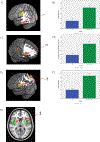Hypoconnectivity of insular resting-state networks in adolescents with Autism Spectrum Disorder
- PMID: 30594068
- PMCID: PMC6901290
- DOI: 10.1016/j.pscychresns.2018.12.003
Hypoconnectivity of insular resting-state networks in adolescents with Autism Spectrum Disorder
Abstract
Autism Spectrum Disorder (ASD) is characterized by deficits in social interaction and communication. The anterior insula (AI) participates in emotional salience detection; and the posterior insula (PI) participates in sensorimotor integration and response selection. Meta-analyses have noted insula-based aberrant connectivity within ASD. Given the observed social impairments in ASD and the role of the insula in social information processing (SIP), investigating functional organization of this structure in ASD is important. We investigated differences in resting-state functional connectivity (RSFC) using fMRI in male youths with (N=13; mean=14.6 years; range: 10.2-18.0 years) and without ASD (N=17; mean=14.5 years; range: 10.0-17.5 years). With seed-based FC measures, we compared RSFC in insular networks. Hypoconnectivity was observed in ASD (AI-superior frontal gyrus (SFG); AI-thalamus; PI-inferior parietal lobule (IPL); PI-fusiform gyrus (FG); PI-lentiform nucleus/putamen). Using the Social Communication Questionnaire (SCQ) to assess social functioning, regression analyses yielded negative correlations between SCQ scores and RSFC (AI-SFG; AI-thalamus; PI-FG; PI-IPL). Given the insula's connections to limbic regions, and its role in integrating external sensory stimuli with internal states, atypical activity in this structure may be associated with social deficits characterizing ASD. Our results suggest further investigation of the insula's role in SIP across a continuum of social abilities is needed.
Keywords: Anterior insula; Autism spectrum disorder; Neurodevelopment; Posterior insula; Resting-state functional connectivity; Salience network; Social communication questionnaire.
Copyright © 2018 Elsevier B.V. All rights reserved.
Conflict of interest statement
Conflict of interest
The authors declare that this research was conducted in the absence of any commercial or financial relationships that could be construed as a potential conflict of interest.
Figures




References
-
- Allen CW, Silove N, Williams K, Hutchins P, 2007. Validity of the social communication questionnaire in assessing risk of autism in preschool children with developmental problems. J. Autism Dev. Disord. 37, 1272–1278. - PubMed
-
- American Psychiatric Association, 2000. Diagnostic Criteria from DSM-IV-TR. American Psychiatric Association, Washington, D.C.
-
- American Psychiatric Association, 2013. Diagnostic and Statistical Manual of Mental Disorders, fifth ed. American Psychiatric Association, Washington, DC.
Publication types
MeSH terms
Grants and funding
LinkOut - more resources
Full Text Sources
Medical
Research Materials
Miscellaneous

